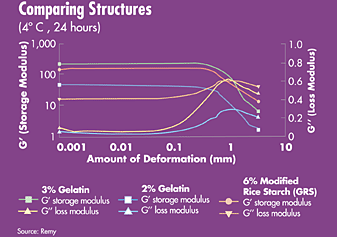One rice starch recently was developed by A&B Ingredients, Fairfield, N.J., to mimic the functionality of gelatin.
Gelatin alternatives are highly desirable to food processors. Religious and vegetarian lifestyle choices may prohibit certain consumer groups from eating foods like yogurt, whipped desserts, lowfat margarine spreads and other products containing gelatin, an animal-based ingredient. Rice starch also can be more economical than gelatin.
“The functionality of gelatin in yogurts is well-documented,” says Gil Bakal, managing director. “But for health and religious reasons, food processors have been seeking vegetarian alternatives to gelatin with little success. While the unique functionality of gelatin has—up to now—been hard to emulate, we offer an extremely viable rice starch-based alternative that is economically priced and kosher.”
The ingredient developed is called Gelatin Replacement System or GRS. Like gelatin, GRS binds water. The GRS system should be dispersed well in cold water and then heated to about 90°F to produce a rigid gel that sustains a large deformation before breaking, while still preserving the sheen and other characteristics associated with gelatin.

A usage level of two to three times the amount of gelatin used is suggested as a good starting point for GRS in most applications. Swiss-style yogurt can be produced by incorporating GRS at a 0.75-0.90% concentration and cup set yogurt can be made by using a concentration of 0.3-0.5%. The ingredient can be used in a number of other food applications, including mousses and whipped toppings.

Bakal notes the company can help tailor a system to each customer's specific requirements, depending on the amount of gelatin they are currently using and the amount of texture and/or sheen they require.
For more information:
Gil Bakal at 973-227-1390
gbakal@abingredients.com
www.abingredients.com
A&B Ingredients Write in 201